外研版必修2 Module 4 Fine Arts – Western, Chinese and Pop Arts Reading and vocabulary 课件(50张PPT)
文档属性
| 名称 | 外研版必修2 Module 4 Fine Arts – Western, Chinese and Pop Arts Reading and vocabulary 课件(50张PPT) | 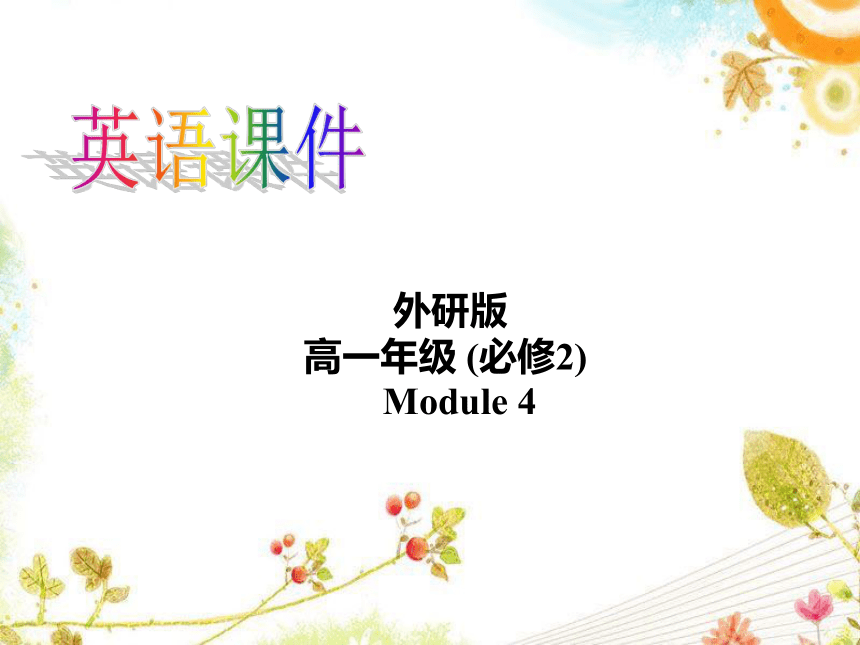 | |
| 格式 | zip | ||
| 文件大小 | 4.3MB | ||
| 资源类型 | 教案 | ||
| 版本资源 | 外研版 | ||
| 科目 | 英语 | ||
| 更新时间 | 2020-05-15 11:37:00 | ||
图片预览

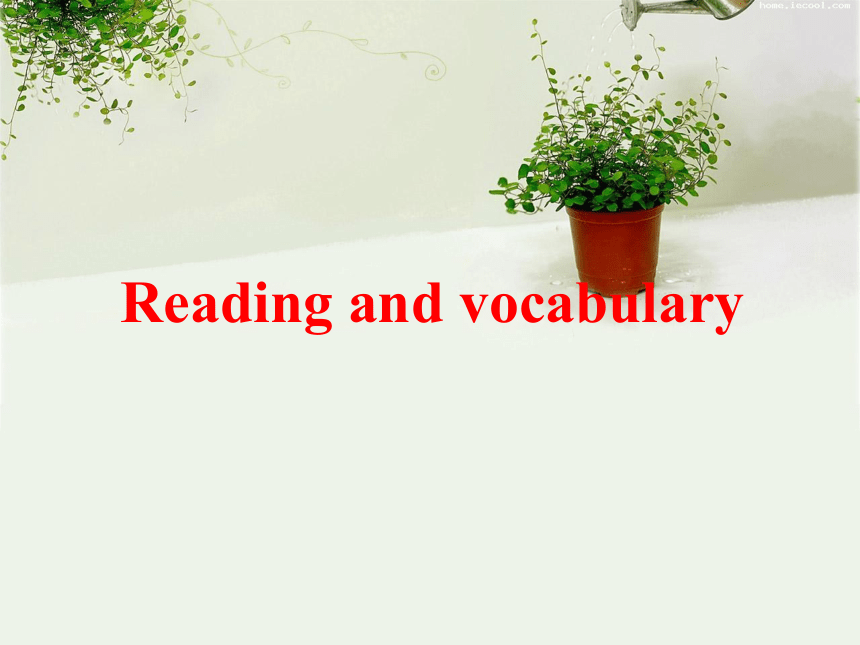
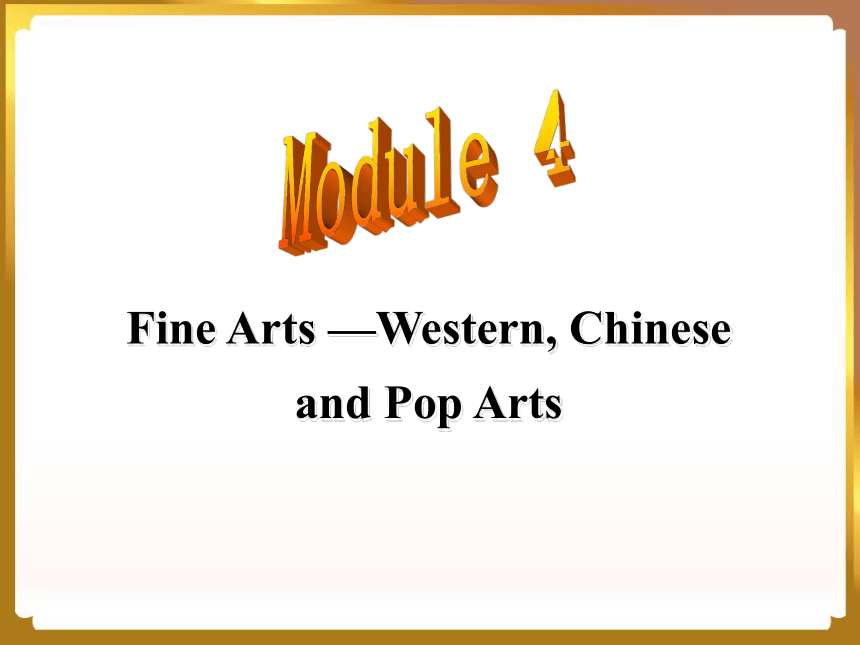
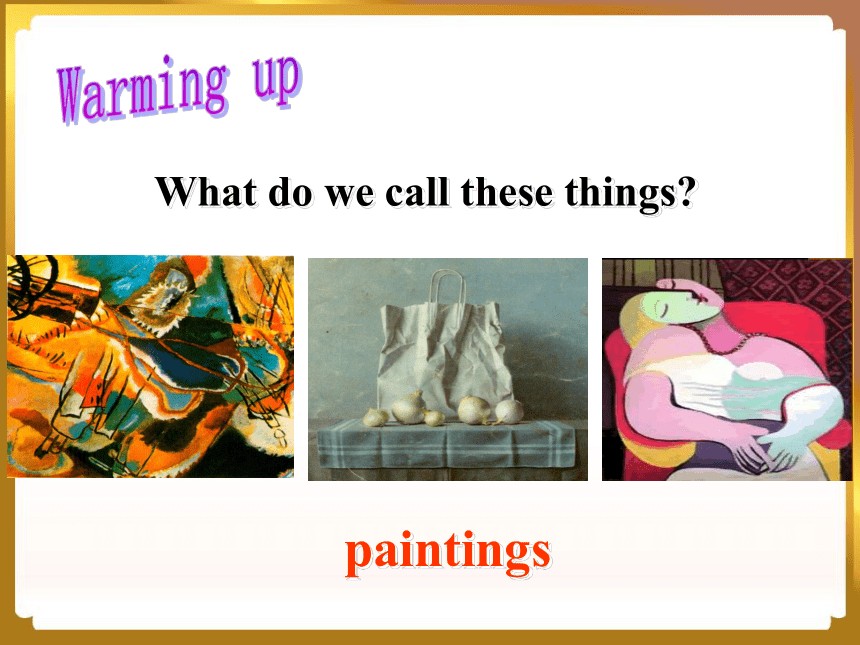

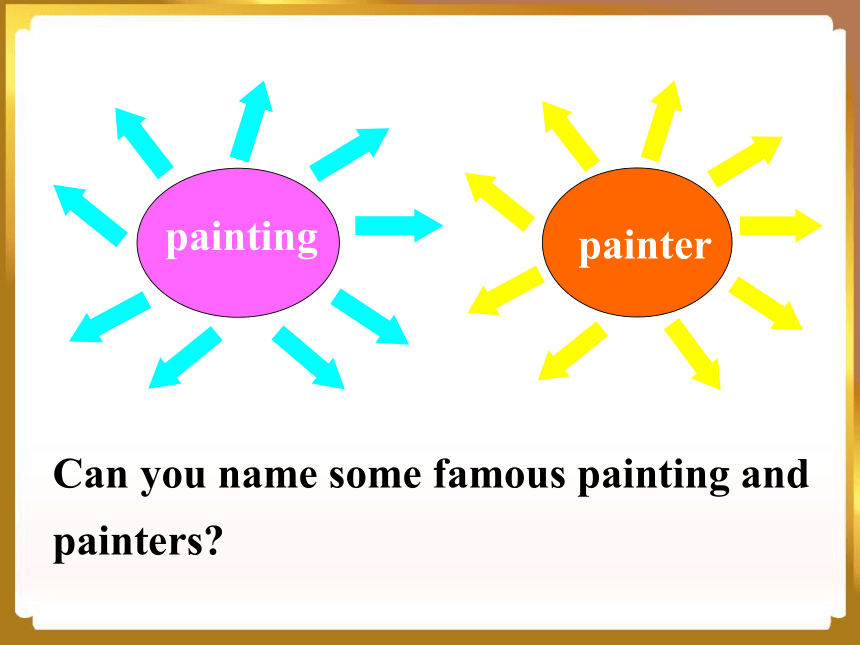
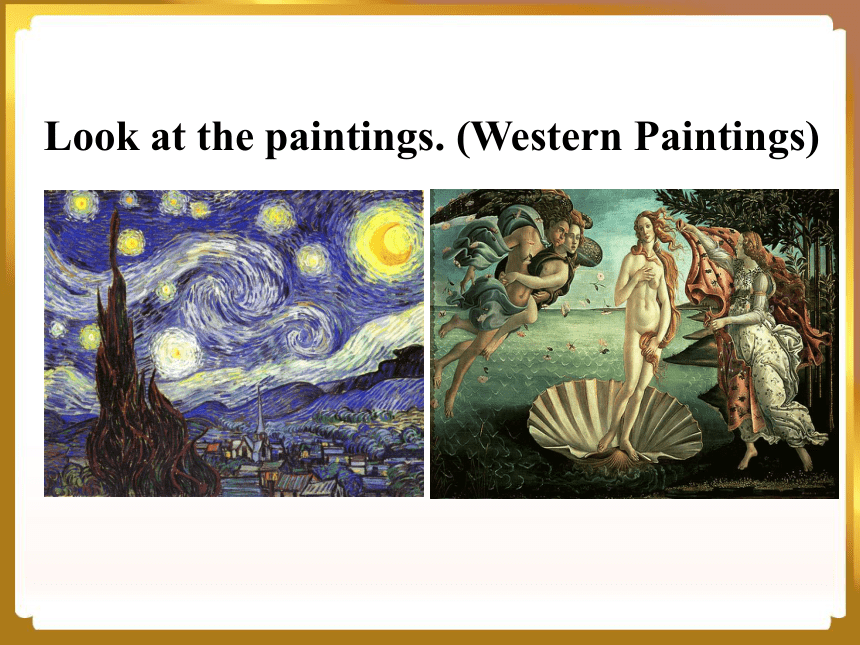
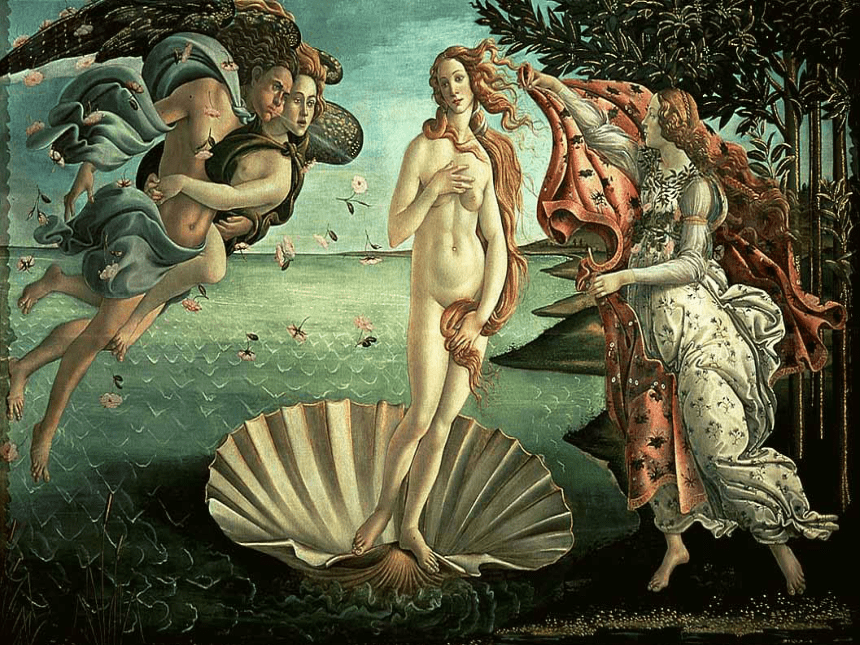

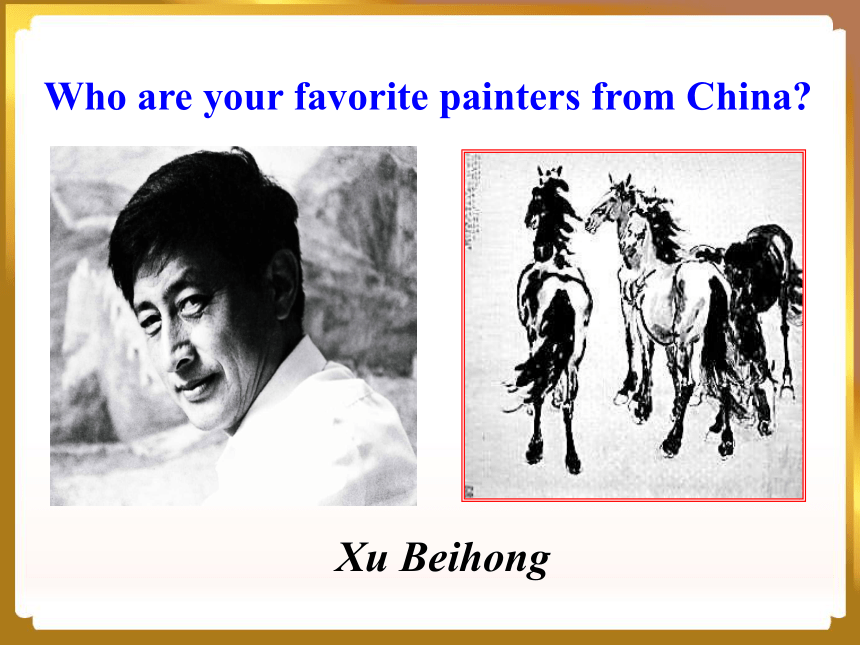
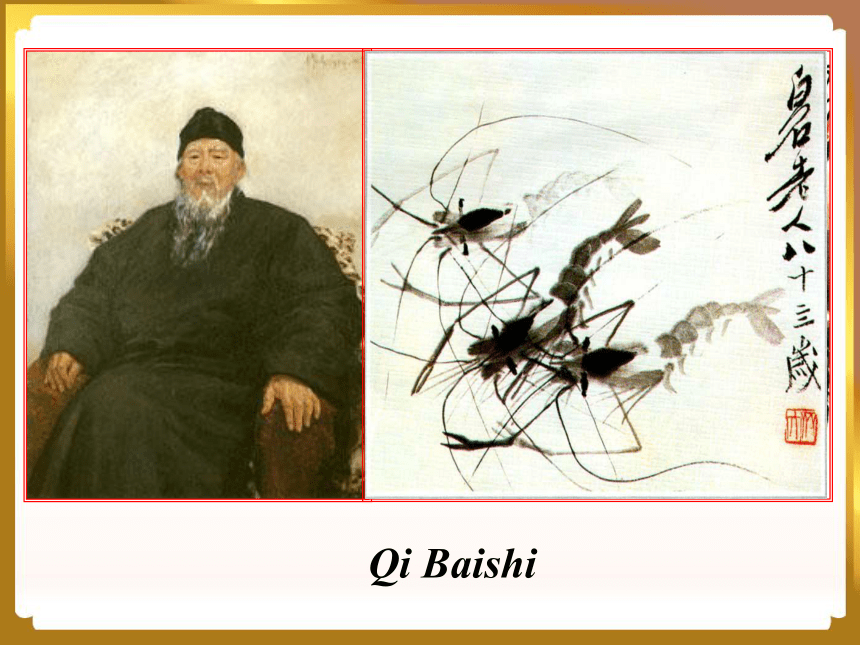

文档简介
(共50张PPT)
外研版
高一年级 (必修2)
Module 4
英语课件
Reading and vocabulary
Fine Arts —Western, Chinese and Pop Arts
Module 4
What do we call these things?
paintings
Warming up
1. If you could have three of these paintings on the walls for your classroom, which would you choose? Discuss your reason.
Look at the paintings. Discuss in groups:
painting
painter
Can you name some famous painting and painters?
Look at the paintings. (Western Paintings)
Can you match the painting and the painters?
Roy
Lichtenstein
Xu Beihong
Who are your favorite painters from China?
Qi Baishi
Zhang Daqian
Match these words and phrases with the definitions.
alive aspect imitate ordinary style (art) movement observe reality
1. the way in which something is done
2. to watch carefully
3. a style of painting adopted by a group of artists
style
observe
movement
4. to copy
5. living or full of life
6. not special or unusual
7. one of the separate parts of something
8. the way something really is
aspect
imitate
alive
ordinary
reality
②1.Match paintings 1-4 with descriptions in paragraphs A-D
1
3
2
4
→ A
→ D
→ B
→C
Say which paintings are mentioned in paragraphs E ( )and F( ).
1,4
2,3
Read paragraphs A-F again and choose the correct answer.
1. The Cubist art movement _____.
A. showed different sides of an object in the same picture.
B. is considered to be the greatest art movement of the twentieth century.
A
2. Pop art ______.
A. advertised the twentieth-century life.
B. tried to show ordinary life in the modern world.
3. Qi Baishi ______.
A. painted in a very unusual way
B. was a very traditional Chinese artist.
B
B
4. Xu Beihong ______.
A. wanted to do more than imitate reality
B. tried to paint horses
5. Wu Hang _____ the picture of a
golden-haired girl.
A. loves B. dislikes
A
B
A
6. Sarah Hardwick thinks that ____.
A. a Chinese artist painted picture 3
B. Pablo Picasso painted picture 3
Global understanding
Read the text carefully and fill in the blanks.
Artist Nationality Status Feature
Pablo Picasso 1.
______ The greatest western artist of the
2. _______ century Painting objects and people, with
3. _____________ of the object or person showing at the same time
Spanish
twentieth
different aspects
Artist Nationality Status Feature
Roy Lichtenstein American A world famous artist of 4. ______ Showing twentieth-century 5. ______
pop art
city life
Artist Nationality Status Feature
Qi Baishi Chinese One of China’s greatest painters Following the 6. _________ Chinese
style of painting; 7. ________ the world of nature very carefully
traditional
observing
Artist Nationality Status Feature
Xu Beihong Chinese One of China’s 8. _________ twentieth-
-century artists Painting in the traditional 9. ____________; showing 10. _______, not just imitating it
best-known
Chinese style
reality
Read the text carefully and decide if these
statements are True (T) or False (F).
1. Pablo Picasso and George Braque started Cubism, one of the most important of all modern art movements.
2. Pop art shows things such as soup cans and advertisements.
Detailed understanding
T
T
3. Xu Beihong is most famous for his lively paintings of shrimps and horses.
4. Wu Hang is crazy about the paintings of Xu Beihong.
5. Sarah’s parents think the painting of the young girl is probably by Picasso.
F
F
F
Key words
Part 1 考纲高频单词
1. dislike v. &n. 憎恶, 不喜欢
【语境检测·先试填】单句语法填空
①Like most people, I dislike ______ (eat) alone in
restaurants.
eating
② Some people really dislike __ when you put
fingerprints on their screens.
③I take __ strong dislike to doing exercise in the
morning.
it
a
【语块归纳·再记牢】
(1)dislike后跟动词时, 要跟动名词形式。
(2)dislike后不直接跟从句, 要先接it再接从句。
(3)have a dislike for / take a dislike to 不喜欢。
2. alive adj. 有活力的; 有生气的; 活着的; 仍然存在的
【语境检测·先试填】
①Doors opened one by one, and the neighbourhood
slowly came ____.
门一扇扇打开了, 整个街又慢慢有了生气。
alive
②The doctors are working hard to _____ him ____.
医生们正在努力维持他活着。
He is said to be one of the best _____ composers.
Although old, he is very ____ and he can give a _____ description of what has happened.
keep
alive
living
alive
lively
【语块归纳·再记牢】
come alive 变得有趣, 活跃起来
keep. . . alive 使……生存下来
bring. . . alive 使变得活跃
【易混辨析】
alive 作表语、补语或后置定语 除了表示“活着的”外, 还表示“有活力的, 有生气的”
live 作前置定语修饰动物 除了表示“活的”外, 还表示“现场直播的”
living 作表语或定语 指“所有的生物”要用“all living things”; 表示“活着的人”, 要用“the living”
lively 作定语、表语或宾语补足语 意为“活泼的”“活跃的”
“充满生气的”
【回眸一练】
用前面学过的知识填空
If you want to _____________________, let the person
know how much you ____________________. 如果你
想保持友谊, 就让那个人知道你多么不喜欢受控制。?
keep the friendship alive
dislike being controlled
3. observe v. 观察; 注意到; 遵守(法律、习俗等); 庆祝(节日等); 评论
【语境检测·先试填】写出黑体部分的含义
① Have you observed anything strange in her words?
( )
②Everyone should observe the law. ( )
注意到
遵守
③Could you tell me how you usually observe
Thanksgiving Day in your country? ( )
庆祝
④ When we attend the parade to _______________
____, we must __________________________. If we
__________________ a red light, we should stop him.
游行庆祝国庆节时必须遵守交通规则。
如果我们看到有人闯红灯, 我们应该阻止他。
observe National
Day
observe the traffic regulations
observe someone run
【语块归纳·再记牢】
(1)observe sb. do sth. 观察某人做某事(全过程)
observe sb. doing sth. 注意到某人正在做某事
(2)observe that. . . 说/评论……
【误区释疑】
observe作“观察; 注意”讲时, 可用省去to的动词不定式或v. -ing形式作宾语补足语; 但如果用于被动语态, 省去的动词不定式符号to要还原。类似的词还有: see, watch, notice, hear, feel, have, make等。
【文化金句】Also known as Tomb-Sweeping Day, the Qingming Festival is usually observed around April 5 and is a time for honoring deceased family relatives.
清明节, 也就是人们熟知的扫墓日, 通常在4月5日左右, 人们常在这一天祭祀亡故的亲人。
4. stand v. (stood, stood)忍受; 站立; 坐落
n. 看台; 摊子; 立场
【语境检测·先试填】写出黑体部分的含义
①I won’t stand your talking to me like that. ( )
②The church stands on the edge of the woods. ( )
忍受
坐落
③He kicked the ball to the stand during the game.
( )
④I couldn’t vote for them because of their stand on
social issues. ( )
看台
立场
完成句子
⑤ I _____ _____ ________ with him because he always
tries to work in his own way.
我不能忍受和他一起工作, 因为他总是试图以自己的
方式工作。
can’t
stand
working
⑥Her bright red hair made her _____ ___ from the
others.
她那亮红色的秀发使她格外显眼。
stand
out
【语块归纳·再记牢】
(1)can’t stand(sb. /sth. ) doing sth.
不能忍受(某人/某物)做某事
(2)stand by 袖手旁观; 支持; 准备行动
stand for 代表
stand out 突出, 显眼
【思维拓展】表示“忍受”的还有bear, endure, put up with
【误区释疑】
stand意为“忍受”时, 常与can, could连用, 用于否定句和疑问句, 其后常接名词、代词或v. -ing形式。不能用于进行时态。
【回眸一练】
用前面学过的知识填空
She ________ that the orphan was being abused and
could not _______, so she decided to adopt him.
她注意到这个孤儿受到虐待, 不能忍受, 所以打算收养
他。
observed
stand it
Homework for today:
1. Read the text again and pick out the sentences you appreciate.
2. Remember the words and phrases we have learned.
3. Find more information about the artists mentioned in the text.
外研版
高一年级 (必修2)
Module 4
英语课件
Reading and vocabulary
Fine Arts —Western, Chinese and Pop Arts
Module 4
What do we call these things?
paintings
Warming up
1. If you could have three of these paintings on the walls for your classroom, which would you choose? Discuss your reason.
Look at the paintings. Discuss in groups:
painting
painter
Can you name some famous painting and painters?
Look at the paintings. (Western Paintings)
Can you match the painting and the painters?
Roy
Lichtenstein
Xu Beihong
Who are your favorite painters from China?
Qi Baishi
Zhang Daqian
Match these words and phrases with the definitions.
alive aspect imitate ordinary style (art) movement observe reality
1. the way in which something is done
2. to watch carefully
3. a style of painting adopted by a group of artists
style
observe
movement
4. to copy
5. living or full of life
6. not special or unusual
7. one of the separate parts of something
8. the way something really is
aspect
imitate
alive
ordinary
reality
②1.Match paintings 1-4 with descriptions in paragraphs A-D
1
3
2
4
→ A
→ D
→ B
→C
Say which paintings are mentioned in paragraphs E ( )and F( ).
1,4
2,3
Read paragraphs A-F again and choose the correct answer.
1. The Cubist art movement _____.
A. showed different sides of an object in the same picture.
B. is considered to be the greatest art movement of the twentieth century.
A
2. Pop art ______.
A. advertised the twentieth-century life.
B. tried to show ordinary life in the modern world.
3. Qi Baishi ______.
A. painted in a very unusual way
B. was a very traditional Chinese artist.
B
B
4. Xu Beihong ______.
A. wanted to do more than imitate reality
B. tried to paint horses
5. Wu Hang _____ the picture of a
golden-haired girl.
A. loves B. dislikes
A
B
A
6. Sarah Hardwick thinks that ____.
A. a Chinese artist painted picture 3
B. Pablo Picasso painted picture 3
Global understanding
Read the text carefully and fill in the blanks.
Artist Nationality Status Feature
Pablo Picasso 1.
______ The greatest western artist of the
2. _______ century Painting objects and people, with
3. _____________ of the object or person showing at the same time
Spanish
twentieth
different aspects
Artist Nationality Status Feature
Roy Lichtenstein American A world famous artist of 4. ______ Showing twentieth-century 5. ______
pop art
city life
Artist Nationality Status Feature
Qi Baishi Chinese One of China’s greatest painters Following the 6. _________ Chinese
style of painting; 7. ________ the world of nature very carefully
traditional
observing
Artist Nationality Status Feature
Xu Beihong Chinese One of China’s 8. _________ twentieth-
-century artists Painting in the traditional 9. ____________; showing 10. _______, not just imitating it
best-known
Chinese style
reality
Read the text carefully and decide if these
statements are True (T) or False (F).
1. Pablo Picasso and George Braque started Cubism, one of the most important of all modern art movements.
2. Pop art shows things such as soup cans and advertisements.
Detailed understanding
T
T
3. Xu Beihong is most famous for his lively paintings of shrimps and horses.
4. Wu Hang is crazy about the paintings of Xu Beihong.
5. Sarah’s parents think the painting of the young girl is probably by Picasso.
F
F
F
Key words
Part 1 考纲高频单词
1. dislike v. &n. 憎恶, 不喜欢
【语境检测·先试填】单句语法填空
①Like most people, I dislike ______ (eat) alone in
restaurants.
eating
② Some people really dislike __ when you put
fingerprints on their screens.
③I take __ strong dislike to doing exercise in the
morning.
it
a
【语块归纳·再记牢】
(1)dislike后跟动词时, 要跟动名词形式。
(2)dislike后不直接跟从句, 要先接it再接从句。
(3)have a dislike for / take a dislike to 不喜欢。
2. alive adj. 有活力的; 有生气的; 活着的; 仍然存在的
【语境检测·先试填】
①Doors opened one by one, and the neighbourhood
slowly came ____.
门一扇扇打开了, 整个街又慢慢有了生气。
alive
②The doctors are working hard to _____ him ____.
医生们正在努力维持他活着。
He is said to be one of the best _____ composers.
Although old, he is very ____ and he can give a _____ description of what has happened.
keep
alive
living
alive
lively
【语块归纳·再记牢】
come alive 变得有趣, 活跃起来
keep. . . alive 使……生存下来
bring. . . alive 使变得活跃
【易混辨析】
alive 作表语、补语或后置定语 除了表示“活着的”外, 还表示“有活力的, 有生气的”
live 作前置定语修饰动物 除了表示“活的”外, 还表示“现场直播的”
living 作表语或定语 指“所有的生物”要用“all living things”; 表示“活着的人”, 要用“the living”
lively 作定语、表语或宾语补足语 意为“活泼的”“活跃的”
“充满生气的”
【回眸一练】
用前面学过的知识填空
If you want to _____________________, let the person
know how much you ____________________. 如果你
想保持友谊, 就让那个人知道你多么不喜欢受控制。?
keep the friendship alive
dislike being controlled
3. observe v. 观察; 注意到; 遵守(法律、习俗等); 庆祝(节日等); 评论
【语境检测·先试填】写出黑体部分的含义
① Have you observed anything strange in her words?
( )
②Everyone should observe the law. ( )
注意到
遵守
③Could you tell me how you usually observe
Thanksgiving Day in your country? ( )
庆祝
④ When we attend the parade to _______________
____, we must __________________________. If we
__________________ a red light, we should stop him.
游行庆祝国庆节时必须遵守交通规则。
如果我们看到有人闯红灯, 我们应该阻止他。
observe National
Day
observe the traffic regulations
observe someone run
【语块归纳·再记牢】
(1)observe sb. do sth. 观察某人做某事(全过程)
observe sb. doing sth. 注意到某人正在做某事
(2)observe that. . . 说/评论……
【误区释疑】
observe作“观察; 注意”讲时, 可用省去to的动词不定式或v. -ing形式作宾语补足语; 但如果用于被动语态, 省去的动词不定式符号to要还原。类似的词还有: see, watch, notice, hear, feel, have, make等。
【文化金句】Also known as Tomb-Sweeping Day, the Qingming Festival is usually observed around April 5 and is a time for honoring deceased family relatives.
清明节, 也就是人们熟知的扫墓日, 通常在4月5日左右, 人们常在这一天祭祀亡故的亲人。
4. stand v. (stood, stood)忍受; 站立; 坐落
n. 看台; 摊子; 立场
【语境检测·先试填】写出黑体部分的含义
①I won’t stand your talking to me like that. ( )
②The church stands on the edge of the woods. ( )
忍受
坐落
③He kicked the ball to the stand during the game.
( )
④I couldn’t vote for them because of their stand on
social issues. ( )
看台
立场
完成句子
⑤ I _____ _____ ________ with him because he always
tries to work in his own way.
我不能忍受和他一起工作, 因为他总是试图以自己的
方式工作。
can’t
stand
working
⑥Her bright red hair made her _____ ___ from the
others.
她那亮红色的秀发使她格外显眼。
stand
out
【语块归纳·再记牢】
(1)can’t stand(sb. /sth. ) doing sth.
不能忍受(某人/某物)做某事
(2)stand by 袖手旁观; 支持; 准备行动
stand for 代表
stand out 突出, 显眼
【思维拓展】表示“忍受”的还有bear, endure, put up with
【误区释疑】
stand意为“忍受”时, 常与can, could连用, 用于否定句和疑问句, 其后常接名词、代词或v. -ing形式。不能用于进行时态。
【回眸一练】
用前面学过的知识填空
She ________ that the orphan was being abused and
could not _______, so she decided to adopt him.
她注意到这个孤儿受到虐待, 不能忍受, 所以打算收养
他。
observed
stand it
Homework for today:
1. Read the text again and pick out the sentences you appreciate.
2. Remember the words and phrases we have learned.
3. Find more information about the artists mentioned in the text.
